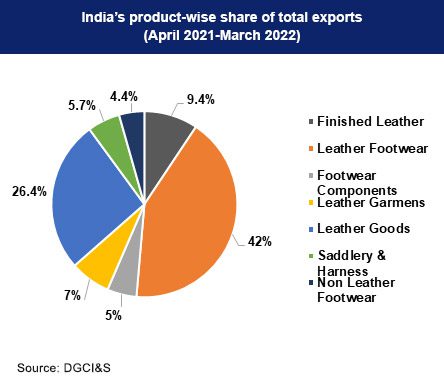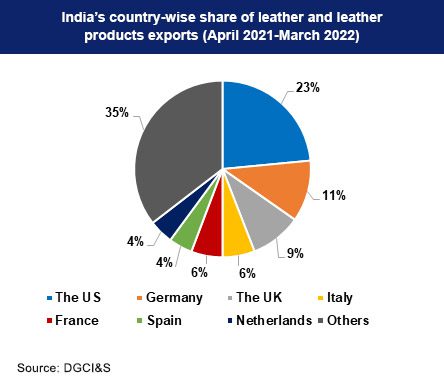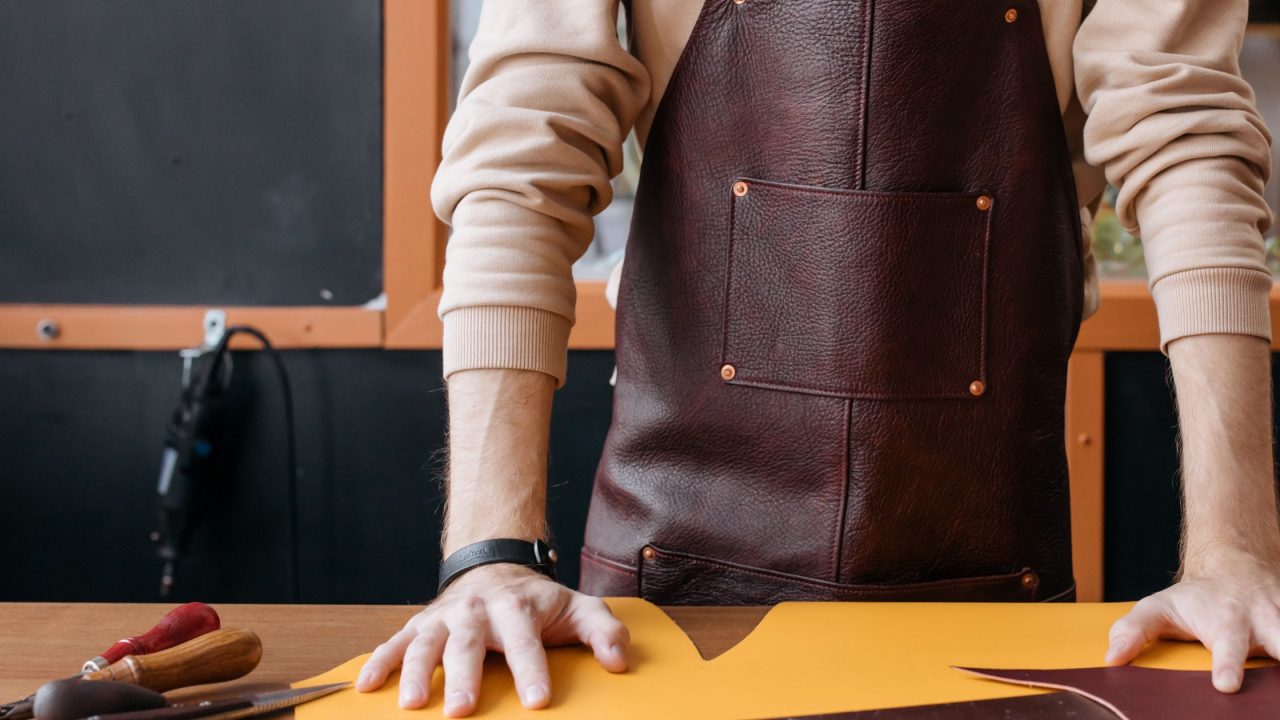While the size of the Indian leather trade and products is estimated to be USD 10 billion, almost USD 5 billion worth of manufactured goods are exported annually.
Leather sector has maintained high export earnings consistently and is one of the top ten foreign exchange earners for the country.
India enjoys the feat of being the second largest producer of footwear, second largest exporter of leather garments, fifth largest exporter of leather goods and third largest exporter of saddlery and harness items. The country produces 9 % of global footwear products, catering both to domestic and export markets.

Further, India’s leather industry produces nearly 13 % of the world’s hides / skins with an annual production of about 3 billion square feet of leather.
The leather industry is a labour-intensive sector that employs over 4 million people in India, the majority of whom are from lower socio-economic backgrounds. Women account for more than 30 per cent of the workforce in the leather products business. With 55 percent of the workforce under the age of 35, India’s leather sector has one of the largest employers of young workforce.
The LEGACY
Leather craft is one of India’s oldest trades and sources of livelihood with its origin tracing back to at least 3,000 BC. Its mention can be found in Indic literature and ancient texts. Patronised regularly by numerous kings and rulers, besides by the general consumers, leather artistry is well developed in India, having unique styles identifiable with various regions.
India’s cattle and buffalo population accounts for 20 %, and its goat and sheep form 11 % of the global number. This place the country in a dominant position in terms of availability of abundant raw material.
With the leather industry being among the oldest trades in the country, India has a strong pool of skilled manpower, requisite technology and an ecosystem for innovation. The manufacturing units are also gradually being modernized and call for eco-sustainable tanning bases and modern manufacturing is gaining momentum. The sector is complemented by a thriving leather chemical and auxiliary industries.
India has been exporting various leather products to more than 50 countries. Australia, Belgium, Canada, China, Denmark, France, Germany, Hong Kong, Italy, the Netherlands. Poland, Portugal, Spain, UAE, the UK, the USA and Vietnam are among the top importers of leather and leather products from India. Incidentally, the top 15 countries account for about 80 % of the total exports.

The USA is the largest importer of leather and leather products from India and it accounted for 25.19 % of the country’s total leather exports during April-August 2022. Germany and the UK accounted for 10.86 % and 9.71 % of the exports during the same period.
India has four primary leather sub-sectors, namely tanning, footwear, leather garments and accessories.
The major production centres of leather and footwear products in India are located in the states of Tamil Nadu, Andhra Pradesh, West Bengal, Uttar Pradesh, Maharashtra, Punjab, Haryana and Delhi.
In the SPOTLIGHT
Sensing the significance and potential of the leather sector for the economy and the people, the Government of India launched the Indian Footwear and Leather Development Programme (IFLDP) in January 2022. Its objective has been to develop requisite infrastructure, increase production, facilitate investments and generate employment in the leather industry of the country. Under this scheme, a financial outlay of Rs. 1,700 crores (USD 220 million) has been provisioned till 2026.
Following are the six sub-schemes under IFLDP:
- Sustainable Technology and Environmental Protection (STEP) – This initiative focused on sustainable and environment-friendly industrial and tanning activities that can help mitigate environmental concerns. In some regions zero liquid and wastewater discharge have already been made mandatory. Assistance for upgradation of Common Effluent Treatment Plants (CETPs) etc. are provided under the scheme.
- Integrated Development of Leather Sector (IDLS) – Encouraging entrepreneurs achieve better productivity through diversification and setting up new units are the main objectives of this scheme.
- Establishment of Institutional Facilities – The scheme facilitates infrastructure upgradation of campuses of Footwear Design and Development Institute (FDDI)
- Mega Leather Footwear and Accessories Cluster Development (MLFACD) – The scheme aims to assist entrepreneurs by providing modern infrastructure, appropriate technology, proper training & skill development, and human resource development inputs.
- Brand Promotion of Indian Brands in Leather – This scheme intents to facilitate international branding and better product visibility to Indian footwear and leather manufacturers.
- Footwear Sector and Development of Design Studios – The scheme provides design support, technical assistance and opportunities for employment and business growth.
Designated agencies are being proposed to be engaged for implementing the sub-schemes. The agencies might be from among NID (National Institute of Design), NIFT (National Institute of Fashion Design), IBEF (India Brand Equity Foundation), IIFT (Indian Institute of Foreign Trade) and similar institutions of repute.
Adding fillip to the leather industry, the CSIR (Council of Scientific and Industrial Research) has developed a ground-breaking “waterless chrome tanning technology” in 2020 that can help the Indian leather industry make leather processing environmentally sustainable. This is a first-of-its-kind technology to reduce chromium pollution load.
The POTENTIAL
The global leather goods market size is valued at USD 424 billion in 2022. This is expected to reach USD 744 billion by 2030. India is well poised to tap this tailor-made potential owing to more than one favourable reason.
Indian finished leather products exports to triple by the year 2025, according to the IFLMEA (Indian Finished Leather Manufacturers and Exporters Association).
Between 2021 and 2028, industry experts predict a compound annual growth rate (CAGR) of 5.9 per cent. The sector is likely to contribute roughly 6 per cent of India’s GDP (Gross Domestic Product).
The GROWTH Drivers
Manufacturers and multi-national companies in Europe and the US are gradually shifting their sourcing to Indian facilities from China, Vietnam and other conventional destinations.
First, China Plus One, or C+1, approach is being adopted by many multi-national companies which is benefiting promising manufacturing bases such as India. Under the policy, they avoid investing only in China and diversify the overdependence towards other countries.
Secondly, India is increasingly becoming competitive in terms of low production costs, speaking especially about leather industry.
Further, India has been developing edges in the form of availability of raw materials and skilled human resource, production technology and supply chain support, long-term stability, safety as well as environmental sustainability in the leather industry.
The START-UPS
Start-ups are at the centre of business innovations, leading to a stronger economy and a healthier job market. India is now home to the third-largest start-up ecosystem in the world and it has contributed to the growth of Indian economy. Start-ups have the ability to contribute around 4-5% to the GDP of India.
A consistently promising sector such as leather has naturally been attracting young Indian entrepreneurs of late. Many start-ups have taken up the potential in the sector and brought innovation like ethical approach, zero-waste production, functional products and artistry etc. This has been creating increasing acceptance and business opportunities both in India and overseas.
Brandless, Brown Bear, Leather Chef, Deby Studio etc. are a few of the start-ups from the leather sector making wave for their innovation and unique appeals.
“Start-ups are playing a key role in the continued growth of leather industry in India,” – Union Minister of State for Science & Technology, Dr. Jitendra Singh had recently acknowledged during a function at CSIR-CLRI (Central Leather Research Institute), Kanpur.
The minister also revealed that the Technology Development Board under the Department of Science and Technology would encourage leather start-up ecosystem further and seed funding to prospective start-ups and innovative entrepreneurs would be offered.
The leather industry, in all likelihood, will continue to occupy its prominence in the Indian economy because of its massive potential for employment, growth and exports in days to come.


